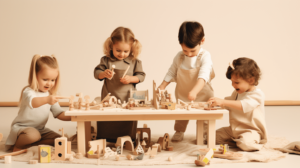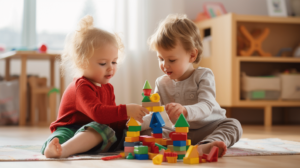
Sibling Relationships – Tips for Encouraging Bonding
Discover effective tips for nurturing sibling relationships and fostering a strong bond between siblings. Create lasting connections and promote harmony.
Creating a peaceful home for toddlers and their siblings involves much more than merely keeping them occupied; it’s about implementing activities that embrace calmness and promote tranquility. Throughout this article, you’ll discover some wonderful, soothing activities and best techniques to harness the calming power of play, music, art, and nature. The aim is not just to keep children engaged, but also to encourage emotional stability, strengthen sibling relationships, and cultivate an overall calming atmosphere at home. This journey, although mostly focused on children, also gives insights to parents on how to help kids embrace calmness, understand their feelings, and enjoy the harmonious ambience at home.
Now is the time to flip the switch from chaos to calm. Let the adventure begin!

We live in a fast-paced world where even the little ones are not exempt from feeling stressed. Wondering how to help ease those tiny worries? A great place to start is incorporating sensory activities into their playtime. After researching and observing the behaviours of children, experts have found that several sensory activities, such as playing with playdough and slime, can have calming effects on children. These activities can not only enhance their motor skills but also stimulate their senses, helping them manage their emotions better.
Playdough and slime are perfect examples of sensory activities to engage in with kids. Their wonderfully gooey texture helps keep the child’s hands busy and their minds focused. Children knead, stretch, roll and squeeze the dough or slime, engaging their sense of touch and sight. There’s an added bonus-the simple repetitive action of moulding and squishing can also help a child self-regulate emotions.
Another way to incorporate sensory calmness into a kid’s routine is through the wonders of water or sand play. Offer them a bucket of water or sand and watch as their worries melt away. They can make ripples, pour, build castles, or simply let the elements slip through their fingers, watching its flow.
Tactile bins are boxes or bins filled with items of varying textures designed to stimulate the tactile senses. They can be filled with materials like dry rice, beans, fabric scraps, or foam shapes. The twinkling allure of tactile bins provides a treasure trove of interesting textures to explore, navigate, and manipulate.
The calming influence of sensory activities like playing with playdough, slime, and tactile bins on toddlers and siblings cannot be underestimated. Integrating such activities into their routine can help them manage their emotions effectively as they learn and grow. In essence, they provide a sense of relaxation and tranquillity in the midst of childhood chaos, ensuring happier, calmer little ones.
Imagination is a strong selling point when it comes to children. Painting a picture in their minds or stirring their minds towards positive thoughts can do wonders. That’s where the idea of breathing and visualization exercises comes in. These two techniques, although simple, are incredibly powerful tools for helping children manage their thoughts, feelings, and even their behavior. They provide kids with the key to unlock their inherent ability for self-regulation. They are like secret weapons helping children to navigate through their ocean of emotions.
Focusing on breath is one of the simplest yet profound exercises that can be taught to kids. This activity revolves around taking deep, slow breaths, and placing one’s concentration on the inhalation and exhalation process. It is recommended to guide children to visualize their breath as a swinging door, opening and closing rhythmically with each inhale and exhale respectively.
The benefits of this technique are manifold:
On the other hand, visualization exercises engage the child’s imagination, fueling an internal journey to a peaceful state of mind. These techniques may include picturing calming scenarios, like a quiet forest or flowing river. The child can weave their mental narratives revolving around these scenarios which allows the mind to focus and feel at ease.
Advantages of Visualization Techniques entail:
Used collectively, these breathing and visualization exercises can empower kids to self-regulate their emotions, be calmer and more controlled in their reactions. They cultivate a sense of mental resilience, equipping them with the ability to handle emotional challenges more proficiently, laying the foundation for better mental health as they navigate towards their adolescence.
Unraveling the beauty vested in music and art, one can’t help but notice the calming effects they both exude. These two companions of solace serve as excellent resources for calming the mind and fostering self-expression. From the euphony of soothing tunes to the dynamic blend of colors in art, music and art poise themselves as an oasis of calmness amidst our sometimes chaotic lives. In this article, we’ll explore them both, and reveal how they help in achieving our inner peace.
The soothing sonnets of music become instantly noticeable when we feel a wave of serenity wash over us as we listen. Music has always been known as a salve that heals societal woes right from the earliest civilizations. Its calming effects have been harnessed through different tunes and rhythms that often help people calm down.
The soft tunes of the piano, the melodious strumming of a guitar, or even the harmonious beating of a drum, all possess a unique calming attribute. Here are some of the benefits of listening to soothing music:
On the other hand, art acts as a silent harbinger of peace, allowing individuals to express themselves creatively. Art activities can soothe frazzled nerves and offer a constructive platform to pour out emotions. From drawing, coloring, to plastering clay, art transcends beyond mere aesthetics and dives deeper into the sea of tranquility.
The benefits of these activities extend beyond relaxation, including:
Never underestimate the power of a personal art space. As we carve out an individual art space at home or work, we present ourselves with an opportunity to retreat into that area and engage in soothing art activities during times of stress.
A simple corner with various art supplies and favorite music can serve as your sanctuary in bustling times. It becomes a unique calm corner, aiding in healing and promoting better mental health.
The harmony between music and art as calming agents plays a critical role in our lives. By integrating soothing tunes and art activities into our daily routine and having a designated art space, we gear ourselves towards a path of self-care. These techniques can also help children adopt practices that lead to calmness and self-regulation. So, let’s embark on this journey of tranquility through music and art, thereby creating an environment that radiates peace within and around us.
Bubble wrap is more than just a shipping essential; it’s an inexpensive, yet effective, calming tool. The act of popping a bubble wrap includes a tactile sensation, which not only provides an outlet for excess energy but also stimulates the brain’s peaceful schematics. Repetitive actions, like popping bubble wrap, can engage the senses and help to shift the mood from anxiety-ridden to serene. It’s all about dictating the tempo of your thoughts and that’s exactly what bubble wrap helps achieve.
Hourglass timers or sand timers, as they are commonly known, serve as a visible display of time, offering a sense of control and structure, particularly for individuals who find it difficult to comprehend the abstract concept of time. Watch the time ebb away in the trickling sands and experience a calming effect, much like meditation or inspecting a serene landscape.
Calm-down jars take on a form of enchanting artistry that can soothe the distressed mind. Typically filled with water, glitter, and some sort of thickening agent, these jars mimic the effect of a snow globe. When shaken, the glitter swirls around, creating a mesmerizing spectacle that aids relaxation. As the glitter gradually settles, so does the jar user’s agitation. The key lies in the objective focus and the gentle but pervasive mesmerization these jars offer.
Lastly, visual aids act as anchors that ground us to reality, staring down anxiety. They can range from flashcards, pictorial schedules, progress tables, to simple emotion charts. They could even be personalized and accompanied by coping mechanisms: for instance, a picture of a stressful location could be paired with simple breathing techniques, encouraging individuals to confront and overcome their fears.
Who knew that simple Calming tools and items could provide sensory input and aid in calming? But indeed, they have a significant impact. They generate a healthy interaction with the surrounding environment, facilitating tranquility via simplicity.
Shaking off stress and embracing tranquility doesn’t always require stillness; sometimes, it involves being physically active. Physical activities allow the body to release pent-up energy, effectively contributing to a calmer state of mind. From outdoor adventures in nature to mindful activities like yoga, let’s discover how physical tasks can soothe your nerves and ensure wholesome wellness.
Venturing outdoors, particularly in natural settings, offers incredible benefits. The sublime beauty of flora and fauna intertwines with physical exertion, resulting in a unique calmness that blankets the whole body – a form of ecotherapy, if you will.
Look out adrenaline junkies — these activities might seem intense, but they’re surprisingly calming.
If you’re looking for something less extreme but equally beneficial, yoga and mindfulness activities could be the answer.
Engaging in physical activities, whether they’re hardcore climbing and jumping or gentle yoga and mindfulness tasks, can be tremendously beneficial in promoting calmness. Workout to relax – it might sound contradictory at first, but once you experience the tranquil afterglow that follows a productive activity session, it’ll all make perfect sense!
Ever walked into a particular space that just instantly makes you feel calm and relaxed? A space characterized by tranquility where you can easily let go of your day’s worries and just breathe? Now, imagine creating such a haven within the walls of your own home. It’s not just possible, but also simpler than you’d think. Follow these steps to transform your home into a sanctuary that radiates tranquility:
The power of a calming corner in your home cannot be overstated. It provides a dedicated space where you, your children, or anyone else can retreat to when feelings become overwhelming.
Think of it as a small oasis amidst the hustle and bustle of daily life; it’s a place to practice mindfulness, sip a cup of tea, meditate, or just breathe. The calm down corner does not need to be elaborate — a comfortable chair, some soothing colours, and perhaps a few personal mementos can make it a haven for relaxation.
One of the current trends in home designs is being eco-conscious, and it’s not difficult to see why. Minimalist designs, natural lighting, and indoor plants can work wonders in transforming your home into a serene, calming environment.
Decluttering is another critical aspect of creating a calming environment. A tidy and well-organised space promotes focus and reduces feelings of stress and being overwhelmed. Make it regular practice to declutter your living and working spaces.
A peaceful home is not just about the physical space; it involves the emotional well-being of those who dwell within it. Thus, considering the feelings of children residing in the house is essential. Herein lies the importance of validating children’s feelings.
Remember, when children are heard and their feelings acknowledged, the resulting calm and understanding profoundly impact the environment in your home. Therefore, always listen to them attentively and allow them to express their emotions freely.
So, there you have it! Putting together a calming space at home doesn’t have to be a complex or costly affair. It’s all about nurturing a space that encourages relaxation, cements the symbiotic relationship with nature, and acknowledges the feelings of every member residing in it.
Bonding activities for siblings are a wonderful way to nurture a friendly relationship amongst your little ones. They do not only promote a positive and peaceful environment at home, but they serve as a touchstone for stronger sibling relationships. These activities, when planned and executed correctly, create a RIPPLE effect – a Respected, Integrated, Peaceful, Playful, Loving, and Engaging atmosphere. So, grab your planner and take notes as we dig into these fantastic bonding activities for siblings.
Creating a peaceful home is like cultivating a beautiful garden. It needs sunlight (love), water (care), and a handful of bonding activities to foster sibling relationships. But what activities, you ask? Here’s a rundown of inspiring activities.
Beyond the peace at home, sibling bonding activities foster friendships between them that could last a lifetime. It develops a sense of appreciation for each other, a healthy give and take, and a profound bond sewn with threads of love, respect, and understanding. Consider these activities:
Introducing regular bonding activities for siblings can open doors to harmonious relationships, a peaceful home, and an extraordinary learning journey. It brings out the best in siblings – their ability to love, share, connect, and grow. The added advantage? Parents get to bask in the bliss of a well-bonded family! Now, who wouldn’t want that? Plan your family activities today and enjoy the transformation they bring.
Creating a peaceful home is a concerted effort that entails engaging children in activities that foster calmness, promoting sibling bonding, and establishing a soothing home environment. These tips and ideas discussed above are not just beneficial for the children but also prime the whole family for a tranquil living experience. It’s all about finding the perfect balance that works for your family!
Lovelycheeks is committed to making parenting easier and more enjoyable by providing insightful advice based on experiences of other parents. Overcoming the challenges of handling toddlers and older siblings need not be a dreadful ordeal. Instead, it can be a fulfilling journey of growth and learning filled with laughter, creativity, and peace. For more enlightening discussions, do visit Lovelycheeks.com, a treasure trove of parenting insights. Learning from others’ experiences can truly illuminate your own parenting path. Always remember, every family is unique, and it’s all about finding what works best for yours. In the peacefulness and tranquility of home, family bonds grow stronger, and childhood memories blossom beautifully.
Some calming activities for toddlers include sensory play with soft materials, quiet reading time, listening to soothing music, coloring or drawing, and gentle yoga or stretching exercises.
You can encourage sibling bonding through activities by planning shared experiences such as nature walks, picnic lunches, board games, arts and crafts projects, cooking or baking together, and family movie or game nights.
Yes, there are plenty of screen-free activities for toddlers and siblings. Some examples include building forts with blankets and pillows, playing dress-up, going on treasure hunts, having a dance party, playing with building blocks, or engaging in imaginary play.
To create a peaceful home environment, establish a consistent daily routine, provide designated calm-down spaces, encourage open communication and problem-solving, practice active listening, set clear and reasonable expectations, and model positive behavior.
Mindfulness activities for toddlers and siblings can include deep breathing exercises, guided meditation tailored for children, practicing gratitude by sharing things they’re thankful for, and engaging in mindful sensory activities like smelling flowers or feeling different textures.
Be the first to See our Posts and latest Guides, and Special Offers like Lovelycheeks on Facebook or follow us on Pinterest!

Discover effective tips for nurturing sibling relationships and fostering a strong bond between siblings. Create lasting connections and promote harmony.

Discover creative and interactive activities for toddlers and siblings to enjoy together. Keep the little ones entertained with fun and engaging ideas.

Discover fun and interactive activities for toddlers and siblings during storytime. Engage their imagination and create lasting memories with these ideas.

Discover fun and engaging activities to help enhance your toddler’s language skills and foster communication between siblings. Start teaching language skills early.